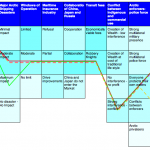Sea Ice
- About
- Imprint
- Scenarios
- Arctic Marine Transportation by 2030
- Introduction
- Aim of this Study
- Key Factor Classification
- Definitions of Key Factors and Future Projections
- 1. Climate
- 2. Legal framework
- 3. Global Trade Dynamics – Global economic growth
- 4. Safety of other Routes
- 5. Socio-economic impact of global climate change
- 6. Oil Price
- 7. Major Arctic Shipping Disasters
- 8. Windows of Operation
- 9. Maritime Insurance Industry
- 10. Collaboration in resource extraction by China, Japan and Russia
- 11. Transit fees
- 12. Conflict between indigenous and commercial use
- 13. Arctic Enforcers
- 14. Energy sources for propulsion
- 15. New resource discovery
- 16. World Trade Patterns
- 17. Regulation in the Arctic
- Consistency matrix
- Scenarios
- Suggest Wild Cards
- Suggest Key Factors
- References
- Glossary
- Yakutat Community Energy Scenarios
- Introduction to Scenario-Management
- The Consistency and Robustness Analysis
- 1. Key Factors and their Future Projections
- 2. Assigning plausibility values to future projections
- 3. Projection Bundles
- 4. Assigning consistency values
- 5. Obtaining overall consistency values for the projection bundles
- 6. The combinatorial problem of the consistency analysis
- 7. The Robustness of a projection bundle
- Disruptive event analysis – Wild Cards
- ScenLab v1.7 Client download
- Arctic Marine Transportation by 2030
Robust Development
This scenario is derived from the most robust raw scenario bundle found by Scen-
Lab. Table 1 and Figure 1 give an overview of this raw scenario and similar raw
scenarios that support the final scenario in this Section. From Figure 1 one can
see all four raw scenarios do not deviate significantly from each other.

Figure 1: Red: overall most robust bundle without Wild Card, green: high robustness, consistency and plausibility, magenta dashed: overall most robust with Wild Card, yellow dashed: robust and plausible.
The scenario: By 2030, the disputes over boundary lines in the Arctic Basin are still lingering. However, these issues are no impediment to conducting business in the Arctic region and disputes between littoral states are handled on a case by case basis. Regulation of national Arctic waters is moderate, but inconsistent among the littoral states. There is no multilateral plan for or enforcement of regulations. One ma jor draw back of this unilateral approach is the non-uniform handling of spill response and other disasters. This leads to critical and negative publicity even for small accidents and to an unwillingness of the maritime insurance industry to fully cover traffic trough Arctic waters.
The warming trend in the Arctic continues, but is less pronounced than some reports predicted. Thus, the ice conditions in most of the Arctic give an moderate window for development and shipping operations. Though, varying ice conditions from year to year impede steady development in some areas. Due to the over all moderate global economic growth, the pressure on other shipping routes has increased steadily, but not excessively. World trade patterns have changed little and high transit fees make it difficult for the Northern shipping routes to be competitive.
The main driver of development in the Arctic are new resource discoveries. The pressure on resources elsewhere accelerates this development. This leads to conflicts of interest with the indigenous people of the North, which mirrors conflicts in other regions across the globe stemming from the fall out of a changing
climate. Development pro jects are often delayed by disputes over rights of use and environmental impact assessments. Very controversial pro jects are at times opposed with physical force.
Further, the continued uncertainty of the oil price has driven moderate development of alternative energy sources for propulsion. These energy sources are mainly used to supplement fossil fuels.
Variations of this scenario (Figure 1) are global conflicts due to a changing climate, high impact of disasters and the sole use of fossil fuels for propulsion.
Wild Cards: Only the Wild Card ’Hot Cold War’ is consistent with this Scenario. Further, it appears robust under the influence of the Wild Card. Note that this is only possible, should this Wild Card take place in years prior to 2030.